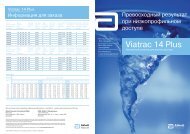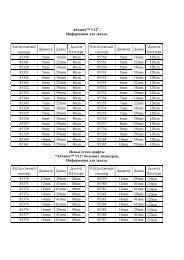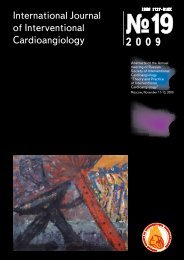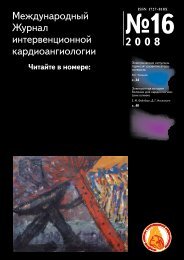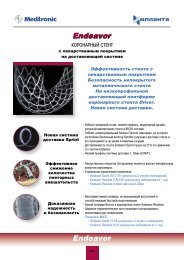International Journal of Interventional Cardioangiology
International Journal of Interventional Cardioangiology
International Journal of Interventional Cardioangiology
You also want an ePaper? Increase the reach of your titles
YUMPU automatically turns print PDFs into web optimized ePapers that Google loves.
MUSCELLANONEOUS<br />
• Cyclic viewing with adjustable speed including<br />
manual step-by-step mode.<br />
• Viewing <strong>of</strong> a sequence <strong>of</strong> film frames in the mode<br />
<strong>of</strong> multiimage.<br />
• Simultaneous viewing on the display <strong>of</strong> 2 and<br />
more frames from different angioscenes.<br />
• Hardware and s<strong>of</strong>tware decompression <strong>of</strong> movies<br />
(scenes).<br />
• Mathematical processing <strong>of</strong> angioscenes.<br />
Following main algorithms are realized in the PC<br />
“Angiography”:<br />
• Quantitative measurements within separate<br />
frames, changing <strong>of</strong> their contrast and edge<br />
enhancement.<br />
• Subtraction (different variants) <strong>of</strong> the angiographic<br />
movie.<br />
• Calculations needed for determination <strong>of</strong> the<br />
extent <strong>of</strong> the coronary vessels narrowing.<br />
• Ventriculographic examinations, needed for evaluation<br />
<strong>of</strong> the left ventricle function, calculation <strong>of</strong><br />
total and segmental ejection fraction.<br />
Methods and algorithms <strong>of</strong> processing are divided<br />
into general-purpose and special. The generalpurpose<br />
algorithms are as follows:<br />
• Calculation <strong>of</strong> area within closed contour on the<br />
image.<br />
• Calculation <strong>of</strong> the given area focal point coordinates<br />
on the image.<br />
• Generating <strong>of</strong> the given area contrast histogram.<br />
• Enhancement <strong>of</strong> image contrast and smoothing<br />
<strong>of</strong> image brightness.<br />
• Edge enhancement and sharpening.<br />
• Smoothing contours and curvature calculation.<br />
Algorithms <strong>of</strong> special-purpose, realized in the PC<br />
“Angiography” are as follows:<br />
• Subtraction.<br />
• Contouring <strong>of</strong> coronary vessels, accentuation and<br />
counting <strong>of</strong> stenotic segments <strong>of</strong> vessels.<br />
• Determination <strong>of</strong> the left ventricle volumes in different<br />
phases <strong>of</strong> cardiac cycle and ejection fraction,<br />
both total and segmental.<br />
• Calculation <strong>of</strong> area enclosed within closed contour<br />
on the image.<br />
• Calculation <strong>of</strong> the given area focal point coordinates<br />
on the image.<br />
• Generating <strong>of</strong> the given area blackening histogram.<br />
• Enhancement <strong>of</strong> image contrast etc.<br />
Prepared report based on the results <strong>of</strong> angiographic<br />
examination is automatically entered in electronic<br />
case history and corresponding section <strong>of</strong><br />
summary. Examples <strong>of</strong> angiographic frames and<br />
results <strong>of</strong> their subsequent mathematical processing<br />
obtained using complex “DIMOL-IK” during angiographic<br />
procedures in real patients <strong>of</strong> a clinic are<br />
presented in Fig. 3-5. Machine form for generating<br />
<strong>of</strong> report for one <strong>of</strong> angiographic examinations is<br />
shown in Fig. 6. Results <strong>of</strong> ventriculographic analysis<br />
and calculation <strong>of</strong> ejection fraction are presented in<br />
Fig. 7. Possibilities <strong>of</strong> image subtraction algorithm<br />
realized in the DIMOL-IK complex are demonstrated<br />
in Fig. 8.<br />
ARCHIVE SYSTEM<br />
Archive system <strong>of</strong> the complex “DIMOL-IK” is built<br />
according to hierarchical approach. There is a local<br />
data archive on each workstation which is necessary<br />
for routine work <strong>of</strong> physician. Current archive<br />
includes all registration and medical data (including<br />
angiographic movies, X-ray and tomographic images<br />
over the last 10 years). Current archive allows to<br />
obtain necessary information on a patient, which is<br />
now being treated or has whenever been treated in<br />
the clinic, at any moment and nearly instantaneously.<br />
Permanent archive provides reliability <strong>of</strong> the whole<br />
archive system by doubling <strong>of</strong> current archive data<br />
on optical media. Data deleted from current archive<br />
are stored in permanent archive as well.<br />
Archive system plays the most important role in<br />
information support <strong>of</strong> a clinic. Facing the patient<br />
admitted with an acute complication <strong>of</strong> cardiovascular<br />
disease, the physician has only a few minutes<br />
to find a unique appropriate solution concerning<br />
the approach and policy <strong>of</strong> treatment. If this patient<br />
has been already treated in a hospital equipped with<br />
electronic archive system, then his/her data are<br />
stored in global archive. Request and receiving <strong>of</strong><br />
а<br />
Figure 3. The circumflex artery before (a) and after (b) PTCA.<br />
а<br />
Figure 4. The left subclavian artery before (a) and after (b) PTCA.<br />
а<br />
Figure 5. The renal artery before (a) and after (b) PTCA.<br />
b<br />
b<br />
b<br />
Electronic Case History for Cardiological Clinics<br />
39




